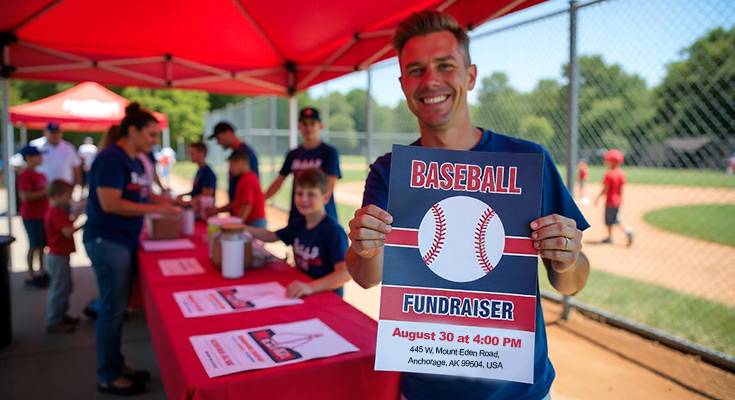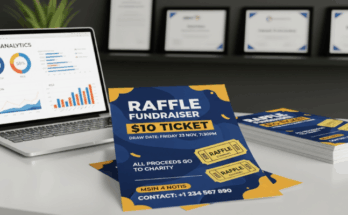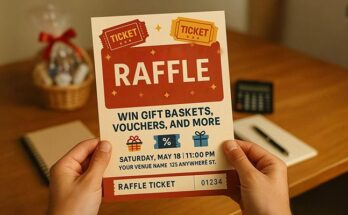The Baseball fundraising events that generate substantial community support combine compelling donation messaging, transparent goal communication, and engaging family entertainment that transforms charitable appeals into community celebration and long-term program investment.
An Effective baseball flyer templates combine community appeal messaging, financial transparency, and entertainment value communication to motivate donor participation while building lasting relationships. Successful fundraising promotion also involves business partnerships, volunteer coordination, and success story validation to create donor confidence and recurring support. These flyers must balance charitable need with positive engagement while demonstrating measurable impact and long-term program value.
Strategic fundraising communication includes appeal strategies that inspire without sounding desperate, financial transparency that builds trust without compromising dignity, and entertainment that draws families in. Using a reliable flyer maker tool can help bring these elements together, allowing organizers to design professional-quality flyer that support sustainable growth and lasting community impact.
What Donation Appeal Messaging Motivates Community Support For Baseball Fundraising Without Appearing Desperate?
Donation appeal messaging requires opportunity framing, community benefit emphasis, and positive impact demonstration that presents fundraising as investment rather than charity. Effective appeals focus on program enhancement, player development, and community value creation that motivates support through vision sharing rather than guilt manipulation. Baseball fundraiser flyers succeed when they position donors as partners in community development while maintaining organizational dignity and professional presentation.
Opportunity-Based Appeal Framework
Investment perspective communication transforms charitable requests into exciting opportunities for community asset development. Present fundraising goals as program enhancement possibilities rather than survival needs. Frame appeals around facility improvements, equipment upgrades, and expanded player opportunities that create lasting community value. Vision sharing strategy emphasizes future program benefits and collective achievement potential.
Community partnership emphasis highlights mutual benefit and shared success rather than one-sided assistance. Position supporters as collaborators in youth development and community pride building. Achievement expansion messaging showcases how donations enable next-level program development, tournament participation, and skill advancement opportunities.
Professional fundraising communication maintains organizational credibility while demonstrating growth potential. Avoid desperate language patterns and focus on strength-based messaging that celebrates current accomplishments while seeking resources for program advancement. Investment framing creates donor confidence through transparent goal presentation and measurable outcome promises.
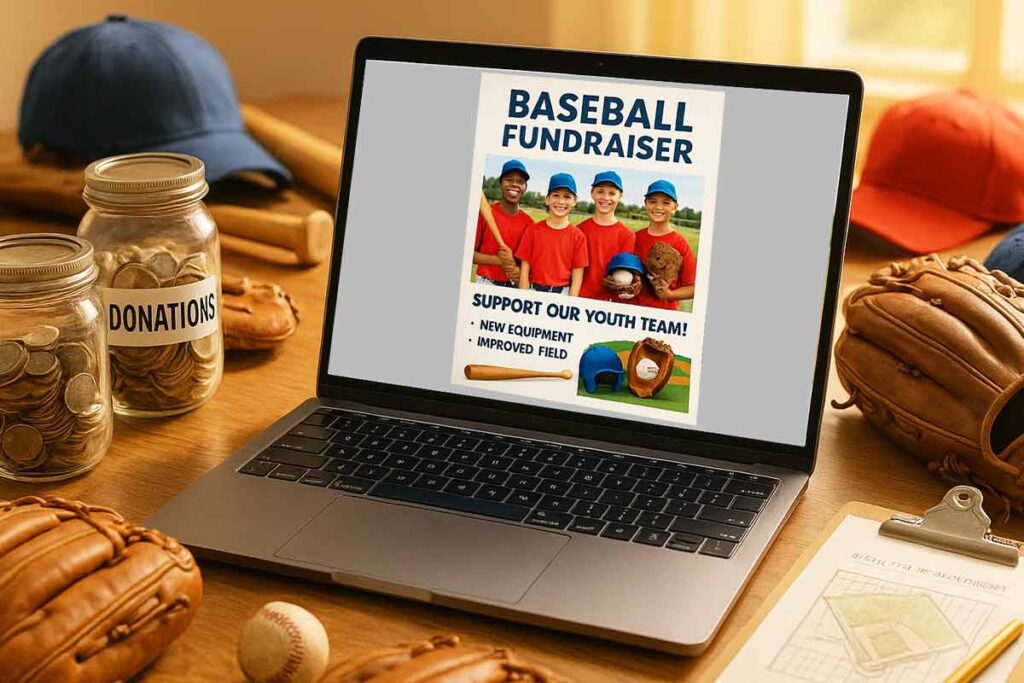
Dignity Preservation Strategy
Strength-based messaging highlights existing program success and seeks support for expansion rather than survival. Celebrate current achievements, player development milestones, and community recognition while positioning fundraising as natural progression toward excellence. Professional presentation maintains organizational credibility and community respect.
Achievement celebration integration features current accomplishments, successful seasons, and positive community impact while requesting resources for enhanced programming. This approach demonstrates responsible stewardship and program effectiveness that justifies continued investment and expansion support.
Organizational pride communication emphasizes program value, community contribution, and positive youth development outcomes. Present fundraising as opportunity to enhance already successful initiatives rather than rescue struggling programs. Confidence projection through professional language and clear vision presentation builds donor trust and community support.
Community Value Proposition
Mutual benefit demonstration shows how program success contributes to community health, youth development, and local pride creation. Baseball programs provide safe youth activities, community gathering opportunities, and positive recreational outlets that benefit entire neighborhoods. Economic impact integration features local spending, facility usage, and business engagement generated through program activities.
Legacy building emphasis includes long-term community benefit and generational impact created through sustained program investment. The National Youth Sports Strategy emphasizes that successful youth sports programs unite communities around a shared vision where all youth have the opportunity, motivation, and access to play sports (U.S. Department of Health and Human Services, 2019).1 Position donors as community development leaders who create lasting positive change for current and future youth participants. Success partnership framing presents contributors as collaborators in community enhancement rather than mere financial supporters.
Program ripple effects extend beyond individual players to include family engagement, volunteer opportunities, and community connection building. Demonstrate how baseball program success creates positive community assets including facility improvements, youth leadership development, and neighborhood pride enhancement. Local investment messaging emphasizes how donations stay within community and generate ongoing benefit through program activities, facility maintenance, and youth development outcomes that strengthen community fabric and create lasting positive impact for residents.
Create compelling donation appeals with professionally designed baseball fundraising flyers available on DesignWiz that transform charitable requests into community investment opportunities.
- Baseball Fundraiser Event Flyer
- School Baseball Fundraiser Event Flyer
- Exciting Blue Community Baseball Fundraiser Event Flyer
Read More: Baseball Tournament Flyers: Complete Competition Event Promotion Guide
How Do I Communicate Specific Fundraising Goals and Fund Allocation Transparency in a Baseball Fundraiser Flyer?
Fundraising goal communication requires specific target presentation, allocation breakdown clarity, and accountability demonstration that builds donor trust while motivating contribution. Research shows that charitable nonprofits must continuously earn the public’s trust through their commitment to ethical principles, transparency, and accountability (National Council of Nonprofits, 2024).2 Effective transparency balances detailed information with accessible presentation that shows responsible stewardship and measurable impact potential. Baseball flyers must combine clear financial objectives with systematic transparency that demonstrates professional fund management while encouraging community participation through visible progress tracking and outcome accountability.
Goal Specificity Framework
Target amount justification includes detailed cost breakdowns and specific purchase identification that connects donations directly to program improvements. Present concrete objectives like “$15,000 for new batting cage installation” rather than vague “equipment needs” to help donors visualize their investment impact. Timeline communication features fundraising phases, milestone celebrations, and completion target dates that create urgency while maintaining realistic expectations.
Progress tracking visibility includes public update systems and achievement recognition throughout campaign duration. Display thermometer graphics showing current funding levels alongside specific purchase thresholds that unlock program enhancements. Break large goals into smaller milestones that allow regular celebration and donor appreciation. Include completion percentages and remaining amounts needed to maintain momentum and encourage continued participation.
Build donor trust with transparent fundraising goal flyers featuring progress tracking and budget breakdowns using DesignWiz’s accountability-focused template collection.
- Dynamic Green Baseball Fundraiser Dinner Event Flyer
- Community Baseball Fundraiser Event Flyer
- Local Baseball Fundraiser Event Flyer
Allocation Transparency System
Detailed budget presentation includes major expense categories, administrative costs, and direct program benefit allocation that demonstrates responsible stewardship. Present clear percentages showing how funds distribute across equipment purchases, facility improvements, and program operations. Administrative costs should remain minimal and clearly justified to maintain donor confidence in fund utilization efficiency.
Cost-benefit demonstration shows donor investment impact and specific outcomes enabled by contribution levels. Connect dollar amounts to tangible improvements like “Every $50 funds one player’s equipment set” or “$500 sponsors team transportation for entire season.” This approach helps donors understand their individual contribution significance while encouraging larger donations through demonstrated value creation.
Stewardship assurance includes oversight procedures, accountability measures, and fund management transparency through board involvement and financial review processes. Mention annual audits, treasurer reports, and budget approval procedures that ensure proper fund handling.
Read More: Baseball Flyer Budget Solutions: Cost Optimization & Resource Efficiency
Accountability Communication Strategy
Impact measurement commitment includes specific outcome tracking and donor reporting systems that demonstrate results achievement. Promise quarterly progress reports showing fund utilization, program improvements, and participant benefits that validate donor investment effectiveness. Create systematic documentation processes that capture before-and-after comparisons and measurable program enhancements enabled by fundraising success.
Financial oversight explanation features board involvement, audit procedures, and responsible fund management practices through established organizational structures. Detail committee oversight responsibilities and approval processes that ensure proper fund allocation. Include contact information for financial questions and transparency requests that demonstrate openness and professional management.
Results sharing promise includes post-campaign reporting, success documentation, and appreciation recognition for contributor investment through systematic follow-up communication. Commit to specific reporting timelines and formats that keep donors informed about their investment outcomes. Plan appreciation events that showcase program improvements and acknowledge donor contributions publicly.
Community involvement integration features donor input opportunities and collaborative decision-making in fund utilization priorities. The UK government’s fundraising guidance emphasizes that effective governance systems should allow trustees to hold others accountable and access appropriate information for informed decision-making (GOV.UK, 2022).3 Create advisory committees or feedback systems that include major donors in program planning decisions. This approach builds stronger relationships while ensuring fund usage aligns with community priorities and donor expectations.
Effective transparency communication transforms fundraising from charity requests into community investment opportunities that demonstrate professional management and measurable outcomes through systematic accountability and regular donor engagement.
What Event Entertainment and Family Activities Make Baseball Fundraising Events Appealing Beyond Donations?
Event entertainment value requires family activity integration, multigenerational appeal, and experience creation that makes fundraising events desirable destinations rather than obligation attendance. Effective entertainment balances cost management with attraction value while creating positive associations and memorable experiences that encourage community participation beyond charitable motivation.

Family Engagement Framework
Multi-age activity planning creates simultaneous entertainment for children, teens, adults, and seniors through diverse programming. Interactive baseball experiences feature skills contests like home run derbies, pitching accuracy challenges, and base-running competitions that engage participants of all skill levels.
Food and social integration creates festival atmosphere through community potluck coordination, local restaurant partnerships, and themed concession stands. Game booths, face painting stations, and balloon artists provide child-focused entertainment while adult networking areas and senior seating create comfortable spaces for extended family participation.
Live entertainment coordination features local school bands, youth choir performances, and community talent showcases that highlight neighborhood involvement. Parent participation activities include coaching demonstrations, equipment maintenance workshops, and fundraising strategy discussions that create educational value alongside entertainment appeal.
Design exciting event promotion flyers that highlight family entertainment and activities with DesignWiz’s engaging baseball fundraising event flyers.
- Charity Baseball Event Sports Flyer
- Local Baseball Fundraiser Event Flyer
- Exciting Blue Community Baseball Fundraiser Event Flyer
Community Celebration Strategy
Local talent showcase integration demonstrates community pride through school band performances, youth group presentations, and volunteer recognition ceremonies. Achievement recognition features player awards, coach appreciation presentations, and volunteer celebration that honors community contributions while entertaining attendees.
Tradition building elements establish annual event anticipation through signature activities, memorable entertainment features, and anticipated highlights that create recurring attendance motivation.
Historical program recognition includes photo displays of past teams, achievement timelines, and legacy player acknowledgments that create emotional connection and community continuity. Local business participation through donated entertainment services, equipment demonstrations, and product showcases creates mutual benefit while reducing event costs.
Value-Added Experience Creation
Exclusive access opportunities provide behind-the-scenes facility tours, player meet-and-greet sessions, and coaching clinic demonstrations that create unique value propositions unavailable elsewhere. Educational integration features skill development workshops, baseball knowledge presentations, and equipment education that combine learning with entertainment.
Memory creation emphasis includes professional photo opportunities, team autograph sessions, and commemorative activities that provide lasting value beyond single-day attendance.
Cost-conscious entertainment utilizes donated services from community members, volunteer talent coordination, and resource sharing with local organizations that maximizes appeal while controlling expenses. Silent auction integration features donated items, service packages, and experience gifts that create additional fundraising opportunities through entertainment value.
Special recognition moments include first pitch ceremonies, honorary coaching positions, and community leader acknowledgments that create prestige and social value. Interactive technology stations featuring video highlights, social media photo booths, and digital engagement activities appeal to younger demographics while maintaining family-friendly atmosphere.
Weather contingency entertainment includes indoor activity alternatives, covered area programming, and flexible scheduling that ensures event success regardless of conditions while maintaining community engagement and fundraising effectiveness.
Read More: Little League Baseball Flyers: Complete Youth Program Marketing Guide
How Can I Leverage Local Business Partnerships and Sponsorship Opportunities In Fundraising Flyer Messaging?
Business partnership integration requires mutual benefit communication, community investment emphasis, and relationship building that presents sponsorship as marketing opportunity rather than charitable obligation. Effective partnership messaging creates win-win scenarios and demonstrates business value while supporting fundraising goals. Research shows that partnerships across various sectors—including business, community recreation, education, and sports, are integral to improving the youth sports landscape (U.S. Department of Health and Human Services, 2022).4 Successful baseball fundraiser flyers showcase sponsor relationships that benefit both fundraising programs and local business marketing objectives through strategic community positioning.
Mutual Benefit Communication Framework
Marketing value demonstration includes audience reach calculations, community visibility metrics, and brand association benefits that justify business investment. Present sponsorship opportunities through customer connection potential, featuring family-friendly audience exposure and positive community association that builds brand loyalty. Emphasize partnership recognition strategies including prominent sponsor acknowledgment on promotional materials, event signage, and ongoing appreciation demonstration.
Quantify exposure opportunities by calculating event attendance, flyer distribution numbers, and ongoing recognition duration. Include demographic information about fundraising event audiences that align with business target markets. Professional partnership presentation requires formal agreements, reliable execution timelines, and consistent brand representation that maintains sponsor confidence throughout campaign duration.
Community visibility extends beyond single events through ongoing recognition in newsletters, social media posts, and future promotional materials that provide sustained marketing value for business partners.
Community Investment Positioning
Local economic impact emphasis demonstrates how business support contributes to community health, youth development programs, and neighborhood improvement initiatives that create positive business association. Frame partnerships as community leadership opportunities where businesses demonstrate civic responsibility and investment in local youth success.
Brand alignment opportunities connect business values with youth sports development, family entertainment, and community celebration that resonates with customer bases. Long-term relationship building includes ongoing partnership potential, sustained business community engagement, and collaborative future event planning that extends beyond single fundraising campaigns.
Position business partners as community development leaders who support youth programs, family activities, and neighborhood improvement through strategic investment rather than simple charitable donation. This approach creates pride in partnership participation and encourages continued business community involvement.
Sponsorship Value Proposition Development
Tiered sponsorship levels provide various investment options with corresponding recognition benefits, allowing businesses to choose participation levels that match budget constraints and marketing objectives. Create measurable exposure calculations featuring event attendance projections, material distribution reach, and ongoing recognition opportunities that justify investment amounts.
Professional partnership presentation includes formal agreements outlining recognition benefits, timeline commitments, and brand representation standards that ensure reliable execution. Provide detailed exposure breakdowns showing logo placement prominence, mention frequency in promotional materials, and special recognition opportunities during events.
Community leadership recognition positions business partners as youth sports supporters and community development champions, creating positive brand association that extends marketing value beyond immediate event exposure. Include testimonials from previous business partners highlighting community response and customer feedback about their fundraising support.
Partnership packages should emphasize professional execution reliability, consistent brand representation, and measurable marketing returns that justify business investment while supporting program fundraising goals through strategic community engagement.
Showcase sponsor relationships professionally with DesignWiz’s business partnership flyers that emphasize mutual benefits and community investment opportunities.
- Baseball Car Wash Fundraiser Event Flyer
- Baseball BBQ Fundraiser with Grilled Food Specials Flyer
- Baseball Club Promotional Event Flyer
Read More: Baseball Tryout Flyers: Complete Player Selection & Evaluation Process Guide
What Volunteer Coordination and Task Delegation Information Should Baseball Fundraiser Flyers Include?
Volunteer coordination communication requires opportunity variety, skill matching, and contribution clarity that encourages participation while ensuring event success. Research demonstrates that specific volunteer management practices, including matching volunteers with specific tasks, providing training, and recognizing volunteer contributions, significantly impact volunteer satisfaction, motivation, and retention (Penn State Extension, 2022).5 Effective volunteer messaging balances need communication with appreciation demonstration and provides clear expectations and contribution methods that build community involvement without overwhelming potential participants. Baseball fundraiser flyers must present volunteering as valuable community service while demonstrating organizational professionalism and volunteer support systems.
Volunteer Opportunity Framework
Role diversification includes various skill requirements, time commitments, and contribution methods that accommodate different volunteer capabilities and schedules. Include specific positions like setup coordination, registration management, food service support, and cleanup organization with clear time expectations and skill requirements for each role. Skill-based matching systems connect volunteer capabilities with event needs through detailed role descriptions that help people identify appropriate contribution opportunities.
Flexible participation options include pre-event preparation activities, day-of support roles, and post-event follow-up tasks that allow volunteers to contribute based on availability and preferences. Present volunteering as community building opportunity featuring collaborative work groups and mutual support systems that create positive volunteer experiences. Leadership development opportunities include committee roles and organizational skill building that provide personal growth benefits beyond basic volunteer service.
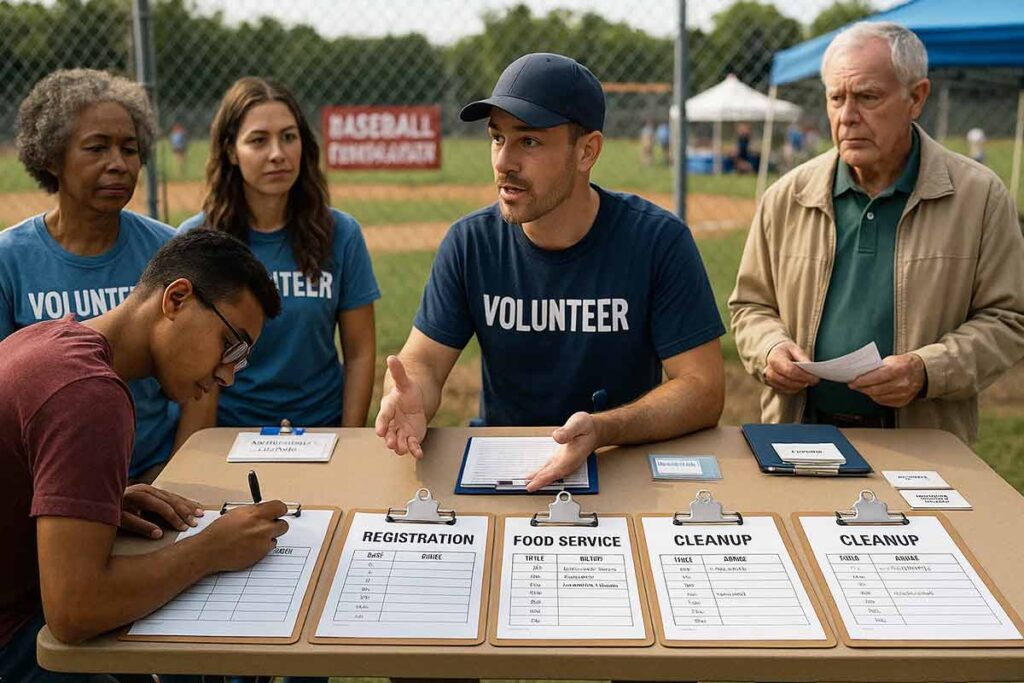
Task Delegation System
Clear responsibility definition includes specific duties, time requirements, and supervision structure that eliminates confusion while ensuring volunteer confidence and success. Provide detailed task descriptions with step-by-step instructions, necessary materials lists, and contact information for questions or support during volunteer activities. Team coordination emphasis features collaborative work groups with designated team leaders who provide guidance and ensure smooth task completion.
Organization systems include volunteer check-in procedures, task assignment methods, and progress tracking that maintain event coordination while supporting volunteer success. Include volunteer training information for complex tasks, safety procedures for relevant activities, and backup plans that ensure event success regardless of volunteer availability changes. Communication protocols feature regular updates, appreciation messages, and feedback collection that maintain volunteer engagement throughout the fundraising process.
Volunteer Appreciation Strategy
Recognition system development includes public acknowledgment during events, appreciation certificates, and ongoing gratitude expression that validates volunteer contributions and encourages continued participation. Feature volunteer spotlights in event communications, social media recognition, and community newsletter mentions that celebrate individual contributions and community service commitment.
Community building integration features volunteer social opportunities, relationship development activities, and shared experience creation that transforms volunteer service into meaningful community connections. Include volunteer appreciation events, informal gathering opportunities, and recognition ceremonies that build lasting relationships beyond single fundraising events.
Skill development benefit communication shows how volunteer participation enhances personal capabilities through leadership experience, organizational skills, and community networking opportunities. Legacy volunteer integration includes experienced volunteer mentorship programs and knowledge transfer systems that ensure event sustainability while providing growth opportunities for new volunteers.
Present volunteer coordination as partnership opportunity rather than labor request, emphasizing mutual benefit and community development through collaborative fundraising success that creates positive volunteer experiences and sustainable organizational support.
Read More: Baseball Camp & Training Flyers: Complete Training & Development Promotion
How Do I Create Urgency For Fundraising Participation While Maintaining Positive Community Relationships?
Fundraising urgency creation requires deadline communication, opportunity scarcity, and consequence clarity that motivates timely action while preserving positive community sentiment. Effective urgency emphasizes limited-time opportunities and program enhancement rather than organizational desperation or community pressure. Strategic messaging frames contributions as investment opportunities with time-sensitive benefits rather than charitable obligations.
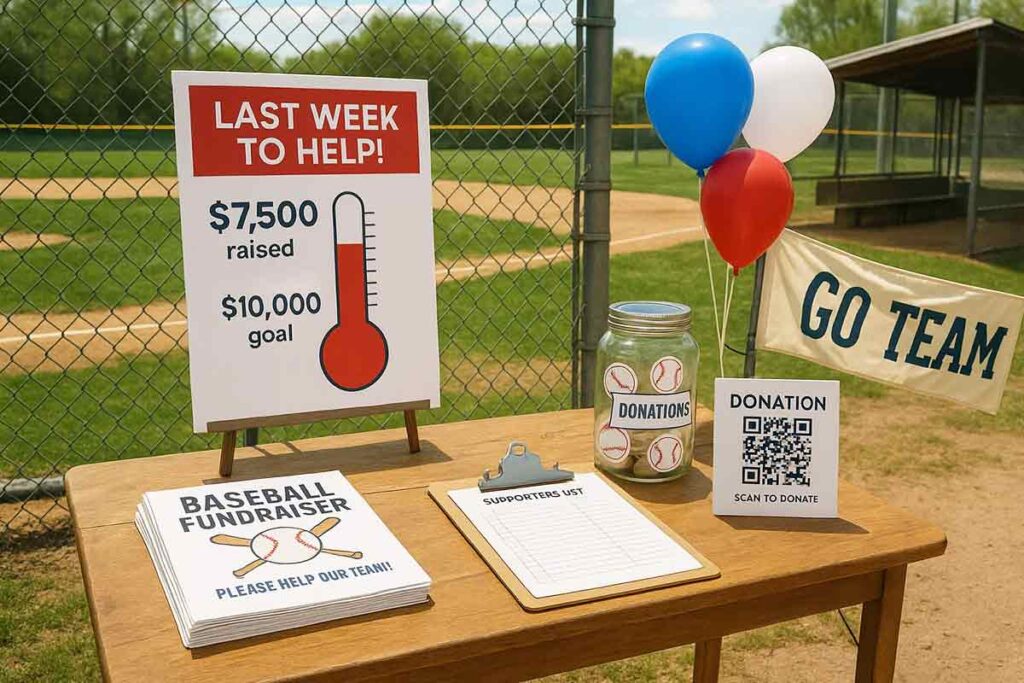
Positive Urgency Framework
Opportunity deadline emphasis creates urgency through early bird benefits, limited availability, and time-sensitive advantages that reward prompt participation. Baseball fundraiser flyers should highlight exclusive donor recognition opportunities available only during initial campaign phases, such as permanent facility naming rights or founding sponsor designation that closes after reaching capacity limits.
Milestone celebration integration maintains positive momentum through progress recognition and achievement acknowledgment throughout campaign duration. Display fundraising thermometers showing community progress toward exciting goals like new equipment purchases or field improvements. Success breeds success when donors see growing community participation and tangible advancement toward shared objectives.
Forward momentum creation uses success indicators and community participation enthusiasm rather than desperation messaging. Phrases like “Join 150+ community members already supporting our championship season” emphasize popularity and community investment rather than urgent need for survival.
Relationship Preservation Strategy
Respectful communication maintains appreciation for all community members regardless of participation level, acknowledging that not everyone can contribute financially while still valuing their community support. Baseball fundraising flyers should express gratitude for attendance, volunteering, and moral support alongside monetary contributions.
Multiple engagement options provide various contribution methods and involvement alternatives, including volunteer opportunities, item donations, and promotional support. This approach prevents exclusion of community members with limited financial resources while maximizing total community involvement.
Pressure-free messaging emphasizes invitation rather than obligation, using language like “We invite you to consider supporting” instead of “You must contribute.” Community choice emphasis respects individual circumstances while maintaining campaign momentum through positive association rather than guilt manipulation.
Strategic Timeline Management
Campaign phase development structures fundraising through awareness building, active solicitation, and appreciation conclusion periods that feel natural rather than manufactured. Initial phases focus on program vision sharing and community education about specific needs and opportunities.
Natural deadline integration uses event dates and program needs rather than artificial pressure creation. Spring training equipment deadlines, facility improvement project timelines, and season preparation requirements provide legitimate urgency without manufactured scarcity tactics.
Community communication balance features regular updates without overwhelming frequency or persistent solicitation. Weekly progress reports during active campaign phases, followed by appreciation periods and program update sharing, maintain engagement without fatigue.
Success celebration planning includes interim achievement recognition and final campaign conclusion festivities that maintain positive community association. Milestone parties at 25%, 50%, and 75% goal completion create celebration opportunities rather than pressure points. Victory celebrations honor all contributors and volunteers, reinforcing positive fundraising experiences that encourage future participation.
Strategic timing respects community calendar conflicts and competing charitable campaigns, positioning fundraising during optimal attention periods while avoiding oversaturation. This demonstrates community awareness and relationship prioritization over immediate fundraising goals.
Read More: Baseball Youth Programs Flyer: Complete Teen Development & High School Preparation Strategy
What Success Story Integration Demonstrates Previous Fundraising Impact and Builds Donor Confidence?
Success story integration requires specific achievement documentation, measurable impact demonstration, and beneficiary testimonial inclusion that validates fundraising effectiveness while inspiring continued support. Effective success communication balances accomplishment celebration with ongoing need presentation and future vision development. Baseball fundraiser flyers showcase program improvements, participant outcomes, and community benefits through concrete examples and verified results that build donor confidence and encourage recurring contributions.
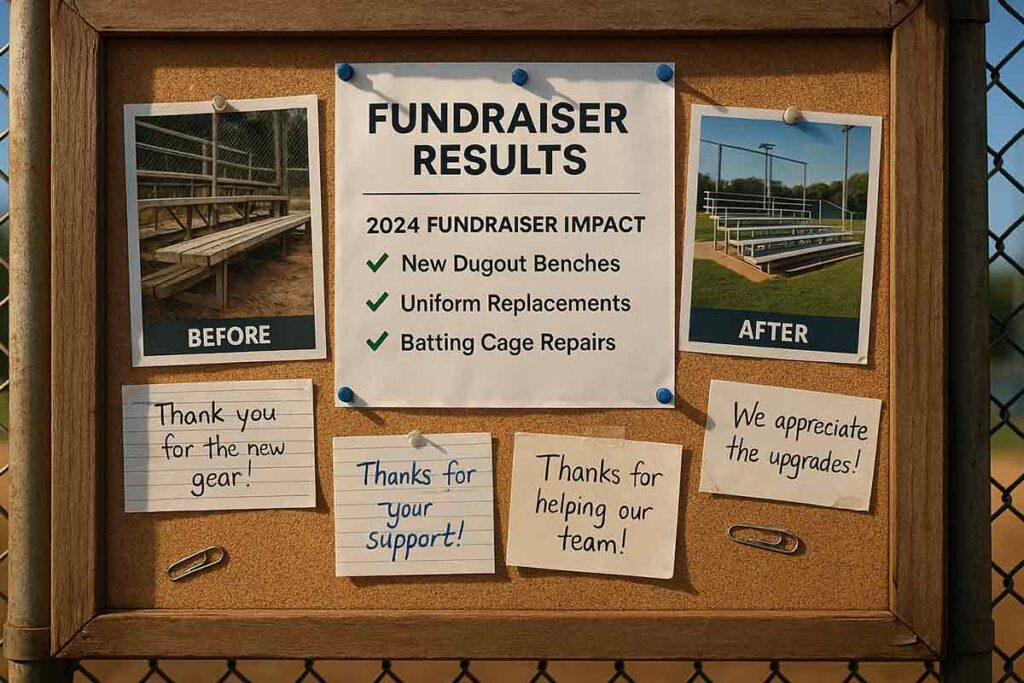
Achievement Documentation Framework
Document specific outcomes through facility improvements, equipment purchases, and program enhancements enabled by previous fundraising campaigns. Present measurable impact through participant numbers, skill development metrics, and community benefit quantification that demonstrates responsible fund utilization. Include visual progress documentation featuring before-and-after comparisons and improvement timeline presentation that validates donor investment effectiveness.
Track equipment acquisitions, facility upgrades, and program expansions funded through community donations. Baseball fundraising flyers document new batting cages, field improvements, uniform purchases, and tournament participation enabled by supporter contributions. Present statistics including player development percentages, team performance improvements, and increased participation rates that correlate directly with fundraising success periods.
Create achievement timelines showing fundraising goal attainment, project completion dates, and measurable program outcomes. Include cost breakdowns demonstrating efficient fund utilization and maximum impact achievement through careful stewardship. Visual documentation through photographs, charts, and progress reports provides tangible evidence of donor investment success and encourages continued community support.
Beneficiary Voice Integration
Feature player testimonials highlighting personal development stories, skill advancement, and opportunity appreciation enabled through fundraising success. Include family perspectives emphasizing program value, community benefit recognition, and gratitude for supporter investment in youth development. Parent testimonials demonstrate broader impact including confidence building, teamwork development, and positive influence extending beyond baseball activities.
Present community impact recognition through local business owner perspectives, school administrator endorsements, and neighborhood resident appreciation for program contributions. Baseball fundraiser flyers include quotes from participants describing scholarships received, college recruitment opportunities, and life skills developed through program participation funded by community donations.
Incorporate coach testimonials explaining program improvements, enhanced training capabilities, and expanded opportunities provided through fundraising achievements. Include statistical improvements in team performance, individual player development, and program growth directly attributable to community financial support. Testimonial authenticity requires specific names, dates, and verifiable outcomes that build credibility and inspire donor confidence in continued investment.
Future Vision Connection Strategy
Connect past achievements to future opportunities through success building narratives showing how previous donor support created foundations for program expansion and continued development. Legacy development emphasis includes long-term program vision articulation and sustained community benefit potential that motivates continued financial investment. Investment continuation logic demonstrates how earlier contributions enabled current success while establishing groundwork for enhanced future programming.
Present community partnership evolution featuring relationship development and increasing mutual benefit through sustained fundraising success cycles. Baseball fundraising flyers showcase facility master plans, equipment upgrade schedules, and program expansion opportunities enabled by consistent community support. Include specific future goals with cost projections, timeline estimates, and anticipated community benefits that justify continued donor investment.
Create momentum building through achievement celebration that positions current success as stepping stones toward enhanced programming, facility improvements, and expanded participant opportunities. Future vision communication connects donor pride in past contributions with excitement about upcoming developments and enhanced community impact potential.
Success story integration transforms fundraising from charity requests into investment opportunities by demonstrating measurable returns, beneficiary impact, and future potential that builds lasting donor relationships and sustainable program funding.
How Can I Optimize Baseball Fundraiser Flyer Distribution Across Multiple Community Channels Effectively?
Multi-channel distribution optimization requires channel-specific adaptation, message consistency maintenance, and timing coordination that maximizes community reach while preserving unified campaign messaging. Effective distribution balances broad exposure with targeted audience engagement through strategic channel selection and timing. Success depends on adapting baseball fundraiser flyers to each platform’s requirements while maintaining consistent branding and coordinated launch timing across all channels.
Channel-Specific Adaptation Strategy
Digital platform optimization includes social media formatting, email campaign design, and website integration tailored to each platform’s specifications. Facebook posts require square image ratios and engaging captions, while Instagram Stories need vertical formats with clear text visibility. Email campaigns benefit from header images and scannable content blocks that work across mobile and desktop devices.
Physical distribution planning features community bulletin boards, business partnerships, and event-based distribution opportunities. Local coffee shops, libraries, and community centers offer high-visibility placement for standard 8.5×11 Baseball flyer. Partner businesses can display a baseball flyer near checkout areas or waiting rooms where families naturally gather.
Traditional media integration includes local newspaper features, radio announcements, and community newsletter inclusion. Weekly newspapers often accept community event submissions with accompanying images. Radio stations frequently announce nonprofit fundraising events during community calendar segments. School newsletters and youth sports league communications provide direct access to target families.
Message Consistency Framework
Unified brand presentation maintains visual consistency and core messaging across all distribution channels while allowing format-specific adaptations. Logo placement, color schemes, and font choices remain constant whether displayed on social media, printed materials, or website banners. This consistency builds recognition and trust across multiple touchpoints.
Channel-appropriate formatting includes size adaptations, content prioritization, and platform-specific optimization without compromising message integrity. Social media versions emphasize visual appeal and shareable content, while print versions prioritize readability and contact information prominence. Email formats balance image quality with fast loading times.
Quality control systems ensure professional presentation and accurate information across all distribution methods. Standardized approval processes prevent outdated information or design inconsistencies from reaching community members. Single-source content management ensures updates propagate across all channels simultaneously.
Timing Coordination System
Campaign phase synchronization includes coordinated launch, sustained promotion, and conclusion timing across channels. Social media posts, email campaigns, and physical distribution should launch within 24-48 hours of each other to create unified community awareness. Staggered timing can dilute impact and confuse potential supporters about event relevance.
Community calendar integration considers local events, competing activities, and optimal attention periods when families make donation and attendance decisions. Avoid launching during major school events, competing fundraisers, or holiday weekends when community attention is divided. Peak engagement typically occurs Tuesday through Thursday evenings for digital channels.
Follow-up sequence planning includes reminder distribution, progress updates, and appreciation communication timing. First reminders should appear 10-14 days after initial launch, with final reminders 3-5 days before event deadlines. Progress updates maintain momentum without overwhelming supporters, typically shared weekly during active campaigns.
Channel-specific timing optimization uses platform analytics and community engagement patterns for maximum exposure effectiveness. Facebook posts perform best between 6-9 PM on weekdays, while email campaigns see higher open rates on Tuesday and Wednesday mornings. Physical distribution should occur during high-traffic periods at partner locations.
Community response monitoring allows real-time adjustments to distribution timing and frequency based on engagement levels and feedback quality across all channels.
People Also Ask: Fundraising Event Implementation Questions
1. What fundraising goal transparency builds donor confidence without revealing organizational desperation?
Share specific use breakdowns, timeline details, and progress tracking while emphasizing program enhancement rather than survival needs. Transparency should demonstrate responsible stewardship and exciting development opportunities.
2. Should baseball fundraiser flyers prioritize entertainment value or charitable impact messaging? Balance both by leading with community benefit while highlighting enjoyable activities. Entertainment attracts attendance while impact messaging motivates donations. Combine fun atmosphere with meaningful purpose for optimal engagement.
3. How much volunteer coordination detail should fundraising event flyers include?
Provide clear opportunity variety and time commitments while emphasizing community building and skill development benefits. Avoid overwhelming detail but ensure adequate information for volunteer decision-making and expectation setting.
4. What local business partnership messaging increases sponsorship participation success?
Emphasize mutual marketing benefits, community investment opportunities, and family audience reach. Present sponsorship as business development rather than charity. Highlight professional recognition and ongoing relationship potential.
5. How do transparent fundraising goals motivate community support without pressure tactics?
Frame goals as exciting opportunities rather than desperate needs. Use milestone celebration and progress recognition to create positive momentum. Focus on community benefit and program enhancement rather than organizational survival.
6. What success story integration convinces new donors to support baseball program fundraising? Include specific achievement examples, measurable improvements, and beneficiary testimonials. Show clear connection between previous donations and tangible outcomes. Demonstrate investment effectiveness and community impact through concrete examples.
7. Should fundraising event flyers emphasize urgency or maintain long-term relationship focus?
Create positive urgency through opportunity deadlines rather than desperation pressure. Emphasize limited-time benefits while maintaining appreciation for ongoing community support. Balance immediate action with sustained relationship building.
8. What entertainment value justifies fundraising event attendance beyond charitable motivation? Offer exclusive experiences, family activities, and community celebration elements. Create value through entertainment, education, and social connection. Events should be desirable destinations that happen to support great cause.
FAQs: Community Fundraising Excellence
1. What fundraising timeline maximizes community participation without causing donation fatigue?
Hold one major annual fundraiser with smaller seasonal events. Space campaigns 12–18 months apart and vary formats. Align with community calendars and include appreciation periods to avoid oversaturation.
2. How do baseball fundraiser flyers handle tax deduction eligibility and donation receipt procedures?
Clearly state 501(c)(3) status and tax-deductible eligibility. Mention receipt timelines, record-keeping help, and year-end summaries. Use professional language and consult a tax expert if needed.
3. Should fundraising flyers include detailed budget breakdowns or focus on program benefits?
Focus on impact and major expense categories like equipment or facilities. Keep it readable; offer full budgets upon request while showing responsible stewardship.
4. What volunteer recognition level attracts participation without creating excessive obligation expectations?
Recognize volunteers with events, public appreciation, and testimonials. Emphasize flexible roles and personal growth. Keep it genuine without making it feel transactional.
5. How do fundraising event flyers coordinate ticket sales and admission pricing strategies?
Offer tiered pricing (individual, family, group), early bird discounts, and bundles. Provide purchase options, deadlines, and consider sliding scale for inclusivity.
6. What weather contingency planning should outdoor fundraising event flyers address?
Include backup venue or date, refund policies, and indoor alternatives. Share how weather updates will be communicated and offer multiple contact methods.
7. How much fundraising campaign detail motivates donors without overwhelming potential supporters?
Share key goals, timelines, and how to participate. Keep flyers concise but link to more details for those interested. Focus on outcomes, not complex logistics.
8. What sponsorship recognition balance acknowledges business support without overwhelming fundraising messaging?
Use tasteful sponsor logo placement, keeping it under 30% of flyer space. Coordinate colors and layout to support, not compete with, the main message.
Conclusion: Community Fundraising Excellence Framework
Successful flyer templates rely on more than just donation requests—they must position fundraising as a shared community investment. By highlighting entertainment elements, local talent, and program achievements, flyers create a sense of celebration and purpose that motivates families to participate beyond obligation. Messaging should focus on program enhancement, facility upgrades, and future vision, using dignified, strength-based appeals that foster pride and ongoing support.
Equally important is building trust through transparency and consistent communication. A Baseball Flyer should clearly outline funding goals, spending plans, and impact tracking, while distributing messages professionally across both digital and physical channels. When combined with appreciation efforts and community involvement, this approach not only boosts current fundraising success but also lays the foundation for long-term donor relationships and sustained support.
Reference
- About the National Youth Sports Strategy. U.S. Department of Health and Human Services, Office of Disease Prevention and Health Promotion. (2019).
- Ethics and Accountability for Nonprofits. National Council of Nonprofits.
- Charity fundraising: a guide to trustee duties. UK Government Publishing. GOV.UK..
- Collaborating to Improve Youth Sports Across the United States. ODPHP News & Events. U.S. Department of Health and Human Services, Office of Disease Prevention and Health Promotion.
- Non-profit Organization Volunteer Management. Pennsylvania State University Extension. Penn State Extension.
